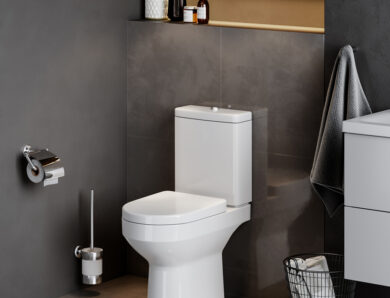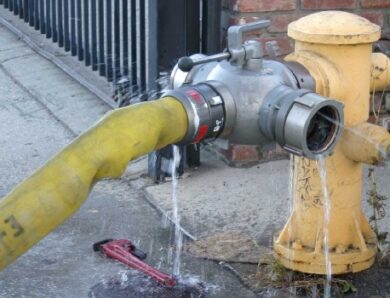Spark extinguisher on the chimney: features and characteristics
Chimney spark arrester is a device, which is used to capture sparks, flying out of the chimney and is a nozzle, equipped with a metal mesh and a protective visor on top. In its performance, the spark arrester is similar to another device, mounted on the chimney - deflector. However, the cost of a spark arrester is lower, it can be easily assembled with your own hands.
To prevent the roof from catching from sparks, flying out of the chimney, a special nozzle is installed on the pipe - a spark arrester
What is a spark arrester?
Absolutely any design, which is associated with the processing of fuel and the removal of combustion products outside the heated premises is a danger to buildings. Especially if the material at home does not have fire resistance (example, wood).
That is why when building a house you need to follow all the rules of fire safety. These rules apply not only to the stove or boiler, but also the chimney design, as the process of fuel processing is accompanied by the release of combustion products into the chimney. This process, usually, accompanied by sparks, which can cause the roof to catch fire. To secure yourself and your home, install a special device - a spark arrester.
The spark arrestor is a device, which is installed directly on the chimney. The composition of such a device includes several structural elements, such as:
- frame;
- net, which catches and extinguishes sparks;
- element, extinguish half;
- visor.
The design of the device is very simple, in essence, it is an ordinary grid with small cells
Features of the spark arrester
Like any other device, spark arrester on the chimney has its own characteristics. Consider the main ones:
- such devices are mounted on chimneys of furnaces, running on solid fuel;
- the size of a cell of a spark-catching grid according to rules should not be more, than 5 mm;
- installation of a spark arrester is mandatory in the case, if the roof is made of flammable materials;
- spark arrestors are needed in this case, if the chimney structure is mounted in a straight line (in the baths, saunas, etc.);
- exept this, such a device prevents debris or birds from entering the canal.
Importantly! Firewood, which contain many resins, not suitable for straight chimneys. If you ignore this, resin, which settles on the grid, will kill it and reduce traction in the structure.
- the spark-catching grid must be cleaned regularly;
- installation of a spark arrester must be included in the chimney design.
Assembling such a device with your own hands is quite simple, however, you should pay attention to the choice of material for the spark arrester. Not every material is suitable for such purposes, example, if you use ferritic steel or galvanized metal - this can lead to rapid wear of the device.
The spark arrester must be installed immediately after the installation of the chimney
The most suitable material for a spark arrester is stainless steel, the thickness of which is 5 mm. Stainless steel products have good strength characteristics, and are resistant to corrosion. exept this, they have a high coefficient of heat resistance.
Types and principle of operation of spark arresters
To date, there are many types of spark arresters, which differ in design features, however, the two most popular types:
- spark arrester, which is a casing of metal mesh;
- spark arrester, made in the form of a deflector.
The main requirement for such devices is that they must not interfere with the normal draft in the structure. Combustion products must pass through the chimney, without encountering any obstacles in its path. exept this, the spark arrester must extinguish all sparks, coming through the pipes.
The dimensions of such products vary depending on the diameter of the pipe. The diameter of the spark arresters can be from 80 to 550 mm. The size of the visor is directly dependent on the diameter of the connecting pipe, which is put on the chimney. This dependence is described in the table below.
Table 1
| Du connecting pipe, mm | Do visor, mm |
| Eighty | One hundred and sixty |
| A table | Two hundred |
| One hundred and ten | Two hundred and twenty |
| One hundred twenty | Two hundred and fifty |
| One hundred and thirty | |
| One hundred forty | Two hundred and eighty |
| Hundred and fifty | Three hundred |
| One hundred and sixty | |
| One hundred and eighty | Three hundred and sixty |
| Two hundred | Four hundred |
| Two hundred and thirty | |
| Two hundred and fifty | Four hundred and fifty |
| Two hundred and eighty | |
| Three hundred | Pyatsot |
| Three hundred and fifty | Five hundred and fifty |
| Four hundred | Six hundred |
| Four hundred and fifty | Six hundred fifty |
| Pyatsot | Seven hundred and fifty |
| Five hundred and fifty | Eight hundred |
The principle of operation of such a device, as a spark arrestor is quite simple. And absolutely all varieties of these devices for furnace pipes work the same:
- Combustion products pass through the chimney through the channel of the pipe.
- At the head they run into an obstacle (spark arrester) and change the direction of movement along the axis.
- At the exit of the structure sparks pass through the spark-catching grid, which extinguishes them.
The spark arrester can be of any type, but all types of devices work the same
Simple versions of spark arresters
If necessary, you can always buy a ready-made device and mount it on the chimney, however, many homeowners are accustomed to self-improvement of their home. It is very easy to make a spark arrester with your own hands:
1. The simplest option, which can be made at home, is considered a device, represented by a cap for a pipe with holes drilled in it. It's worth remembering, what if you decide to make such a spark arrester, then you need to take care in advance to choose the diameter of the cap. Plug, from which in the future the spark arrestor will be executed, must have a cross section, exceeding the diameter of the chimney. This is necessary for that, so that you can easily put such a simple device on the chimney.
The implementation of such a device is not particularly difficult, but, there are some difficulties, which are related to the size and number of holes in the plug. Incorrect calculation of these indicators can lead to that, that the thrust in the structure will decrease. exept this, there is another disadvantage of using such a cylindrical device during operation, it is covered with soot, resulting in an unpleasant odor from the oven.
Council! If sparks in the chimney occur very often or in large quantities, it is worth paying attention to its traction. If the traction is too strong, it is worth reducing it, then this problem should disappear.
2. The second simple option, able to replace a full-fledged spark arrester - metal mesh, which is fixed by means of a special collar on a flue. The disadvantages of this product include:
- the net is quickly clogged with soot, which entails a reduction in traction in the structure;
- does not differ in high efficiency, therefore, it may not give the expected results.
When making a spark arrester with your own hands, you should choose a dome shape, such a device will be effective
3. Installation at the end of the flue pipe in the form of a dome. Dome mesh is considered to be the most effective device among alternatives to full-fledged spark arresters.
Spark arrester with your own hands
For, to assemble a spark arrester on the chimney at home, the following list of tools will be required:
- hammer;
- measuring ruler;
- welding unit or special rivets to connect the elements of the device;
- trade winds;
- clamps;
- drill with a set of drills;
- screwdriver;
- scissors for cutting metal;
- Bulgarian.
It is recommended to select steel for the manufacture of this device, which has anti-corrosion properties. The thickness of the bars for the grid should be as small as possible. The smaller the thickness of the rods, the longer it takes to do so, so that the network is clogged with soot.
Council! If you can not bend the metal mesh, you can use an ordinary hammer. Tap them on the grid - it will relieve tension from the metal and it can be easily bent.
The thickness of the rods for the spark arrester mesh must be at least 1 mm
Consider the procedure for assembling a spark arrester with your own hands:
- First you need to measure the size of the chimney and make a sketch of future parts of the device.
- It is necessary to cut out cardboard models, which will then become a stencil for the manufacture of steel parts.
- You can buy a grid for a spark arrester, and can be made by hand from steel rods. The diameter of such rods should be from 1 to 6 mm.
- By means of welding we join details in a uniform design. After joining the individual elements of the spark arrester, it is necessary to carry out thorough cleaning of joints.
- Then fix all the elements of the spark arrestor with steel rivets.
After, as the product is ready, you can start installing it on the chimney.
Additionally, you can assemble the deflector, it is necessary for this:
- Cut a suitable visor from the metal.
- Then bend the visor at the right angle and secure the bends with steel rivets.
- The finished visor is attached to the base of the spark arrester, using all the same rivets.
Features of installation and operation of the spark arrester
For proper installation of such a device, its cross-sectional dimensions must be selected in accordance with a similar chimney. The simplest option for installing a spark arrester is to insert it into the chimney without any additional fasteners. However, this method is not very reliable. Operation of the spark arrester requires regular preventive cleaning of its grid from soot, therefore its installation is carried out as follows, so that the device can be easily removed at any time. It is strictly forbidden to weld the device to the chimney - the structure must be removable in all cases.
Even if your roof is made of non-combustible materials, there is a danger of that, that sparks, that flew out of the pipe, fall on objects and structures, which are located in your yard and will ignite them. Therefore, the installation of a spark arrester is recommended in all cases without exception.


